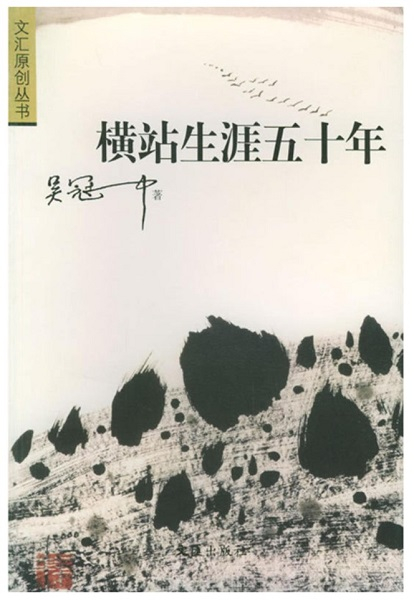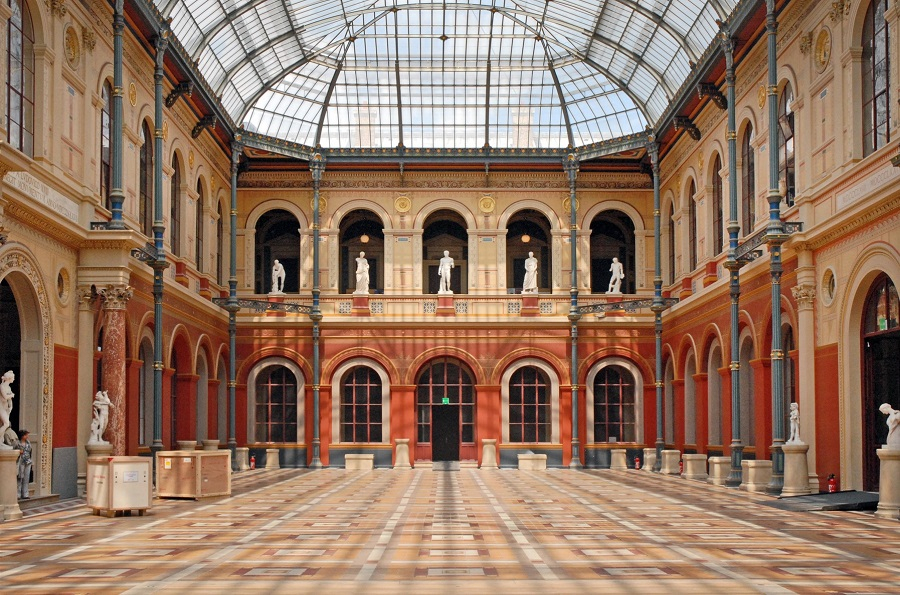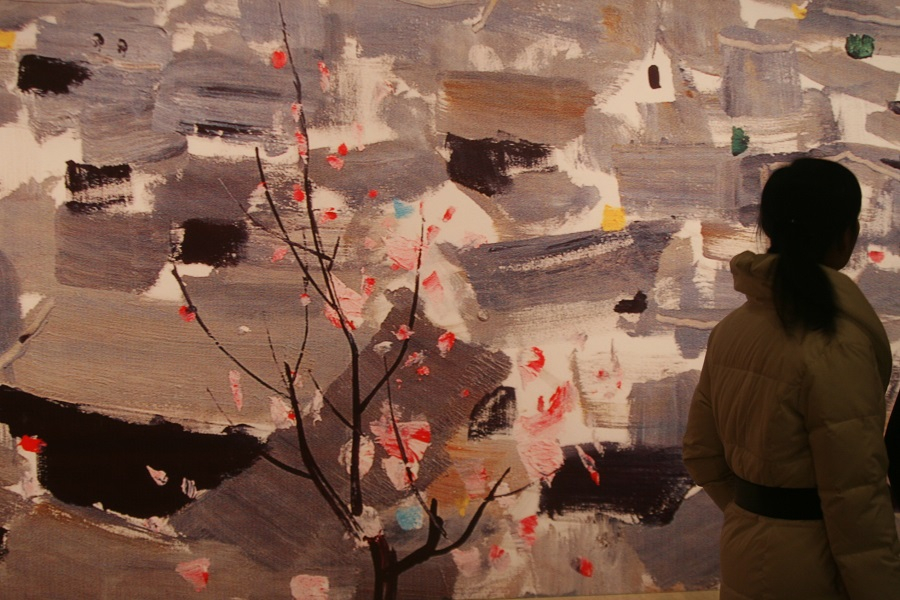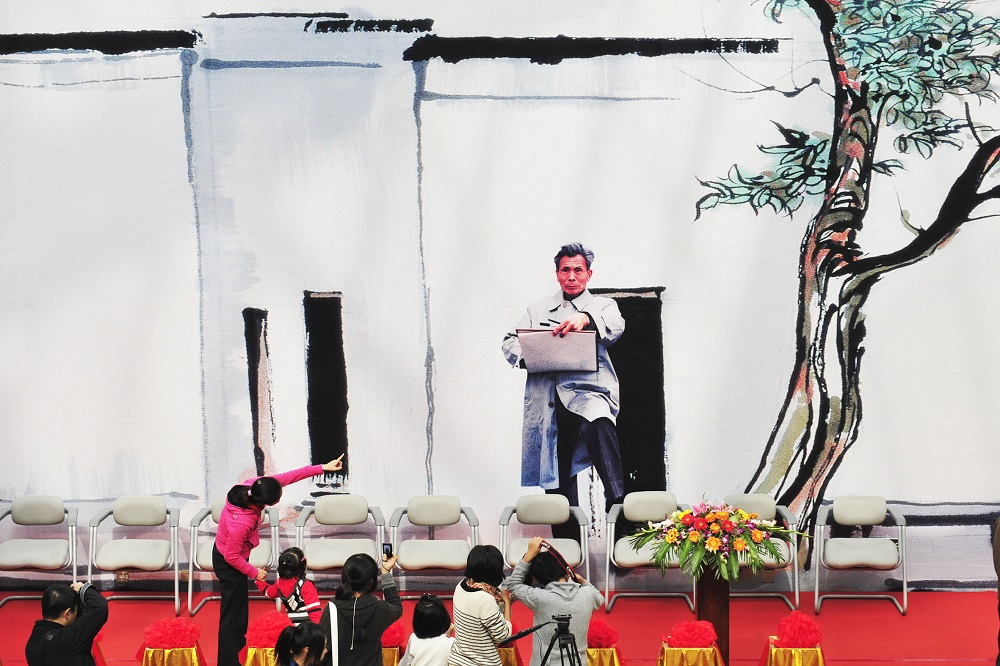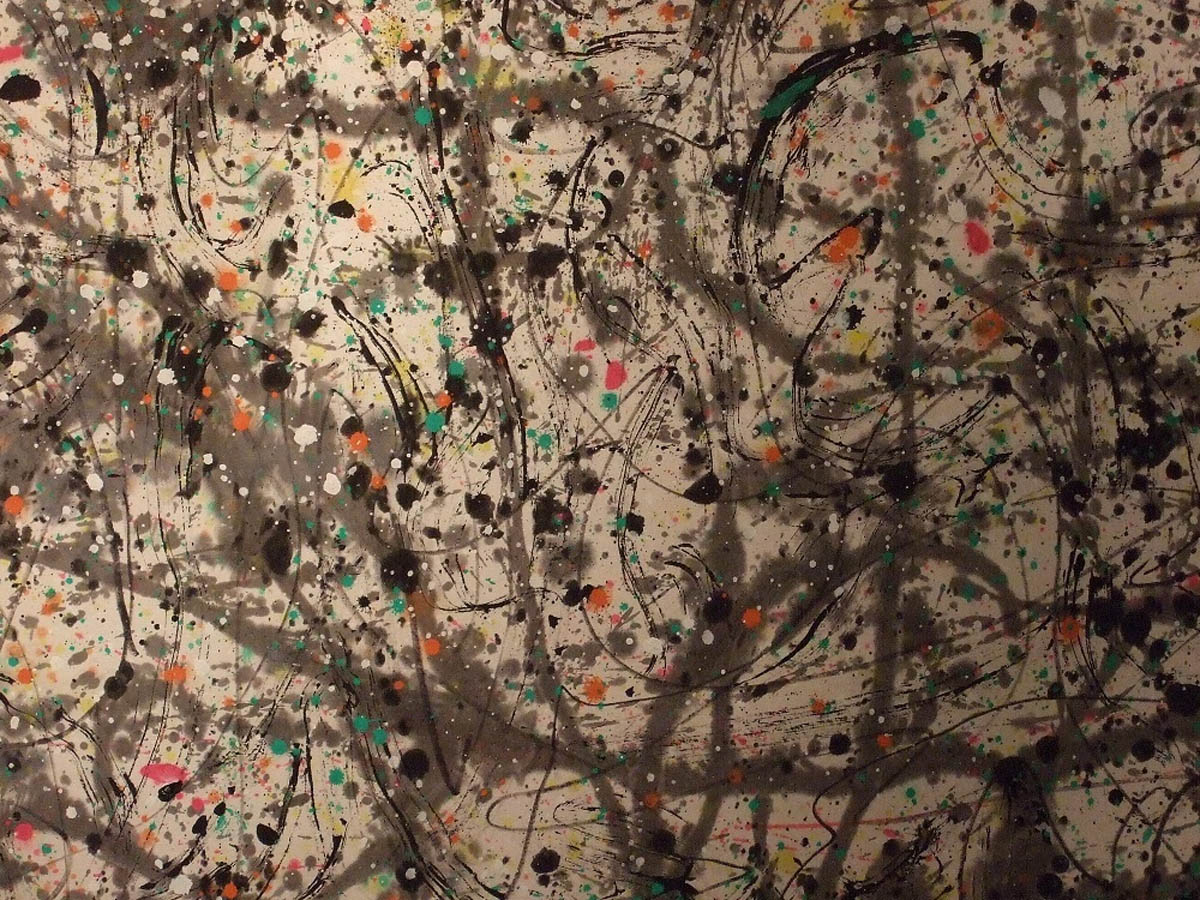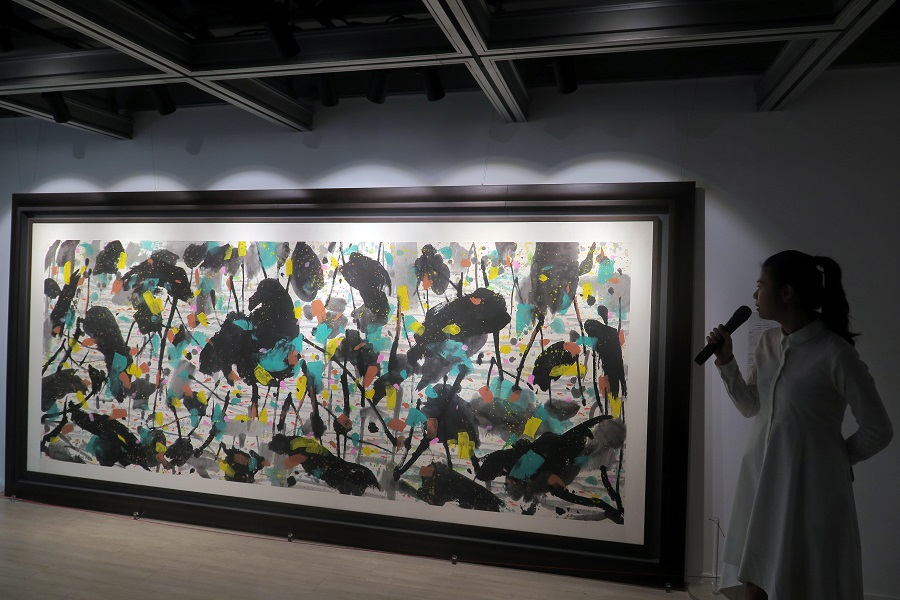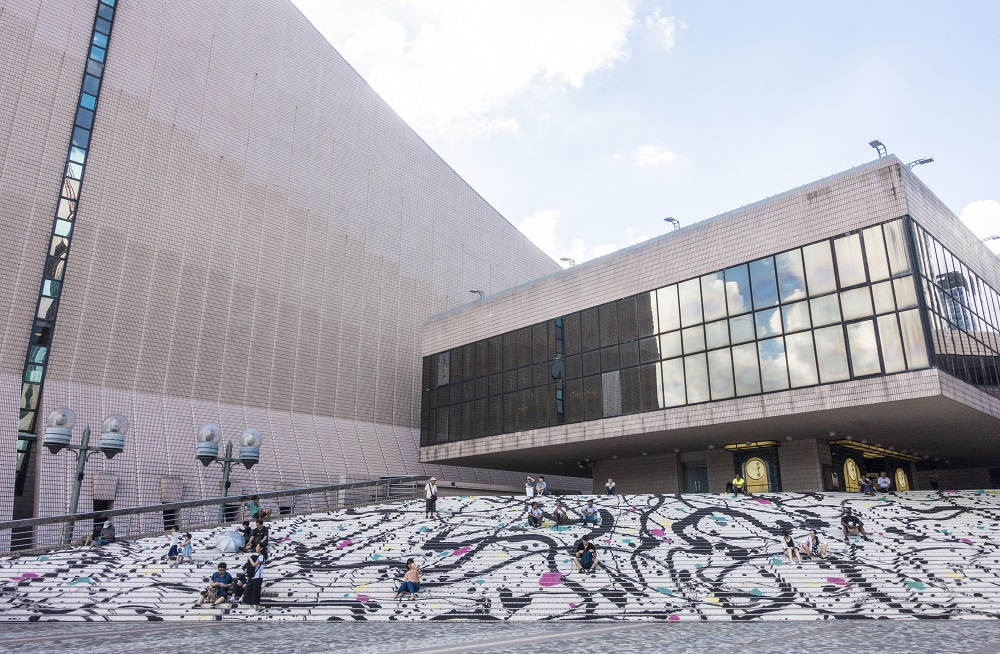Wu Guanzhong (吳冠中) a name celebrated in modern Chinese painting circles, has been described by The Guardian, a British newspaper, as the “Chinese artist who emerged from a cultural straitjacket as a modern master.” Lauded for pioneering the nationalizing of oil painting and the modernizing of Chinese painting, this renowned maestro mastered both Chinese and Western styles, yet rebelled against both to create a unique style that brought together the traditional and modern, Chinese and Western in his lifetime. How did he achieve this?
The name Wu Guanzhong (1919-2010) reverberates in China’s modern painting world. An artist of many “firsts,” Wu Guanzhong was the first 20th-century Chinese artist to have a solo exhibition at the British Museum (1992); the first Chinese artist nominated as Medaille des Arts et Lettres (Art Academician of France) by the prestigious Academie des Beaux - Arts de l' Institut de France (French Academy of Fine Arts) (2002). His work The Zhou Village (周莊) fetched 236 million HK dollars at the Poly Auction's spring sale in Hong Kong in 2016, a record high for contemporary Chinese oil paintings at the time. He was hailed by The Guardian as the “Chinese artist who emerged from a cultural straitjacket as a modern master,” and was credited with nationalizing oil painting and modernizing Chinese painting (guo hua). How did this celebrated master of Chinese painting cast off his cultural constraints to meld the Chinese and Western, the traditional and modern, while refusing to conform to either of them?
Two life-changing decisions
Born in 1919 in Zhakou Township (閘口鄉) of Yixing County (宜興縣), Jiangsu Province (江蘇省), Wu Guanzhong was the son of a schoolteacher of modest means who both taught and farmed for a living. Academically adept since he was a child, Wu Guanzhong’s impoverished family expected him to enter a teaching school to become a teacher after his father, and thus help support the household.
When he graduated from senior primary school, he was, as his family wished, accepted by Wuxi Normal School (無錫師範學校). However, after finishing his three years of junior high school education, he became determined to serve the mission of “saving the country through industry,” and went on to major in electrical engineering at a vocational school run by Zhejiang University. A year later, his life reached its first major turning point.
During his summer vacation in 1935, Wu Guanzhong became friends with Zhu Dequn (朱德群), a student of the National Hangzhou Academy of Art (杭州藝術專科學校). Visiting an exhibition at the Academy, Wu Guanzhong came across paintings and sculptures for the first time - an experience that captivated him and left him shaken, as if he had collided with an “alien world.” A year later, compelled by a “blind love” for art, he turned a deaf ear to his family’s protests, determined to enter the National Hangzhou Academy of Art. He was successful and began working diligently, learning to paint from scratch.
At that time, Lin Fengmian (林風眠), the director of the Academy, and many of its professors were French-educated and followed French Art Academy-based teaching methods. They encouraged a Chinese-Western integrated approach to teaching and provided a liberal artistic atmosphere. Many students, Wu Guanzhong included, modelled themselves on Van Gogh, Picasso and other masters of Western modern art.
When the Second Sino-Japanese War broke out, Wu Guanzhong along with the teachers and students of the Academy had to leave Hangzhou. Despite the turmoil of war and material deprivation, he doggedly continued to pursue art. For a time, he studied oil painting under Chang Shuhong (常書鴻) and Guan Liang (關良), and Chinese painting under Pan Tianshou (潘天壽).
After graduating from the Academy, he became a tutor of sketching and watercolour painting at the Department of Architecture of the National Central University of Chongqing (重慶大學). In 1946 the Ministry of Education selected the first batch of students to be sent abroad for education after the war. The ambitious Wu Guanzhong came first in the Art Examination and soon found himself a zealous new entrant to Paris’s École Nationale Supérieure des Beaux-Arts (National School of Fine Arts), which he had long held in high regard.
During his stay in France, he studied under J. M. Souverbie and other masters of modern art and spent his free time visiting large and small museums and galleries, ravenously seeking the essence of classical European art and modern art.
As time went by, his initial enthusiasm for fulfilling his dream to study in France was gradually replaced by a sense that his Europe-based studies and creativity were disconnected from his native land and culture. He began to entertain the idea of returning to China. A passage from one of Van Gogh’s letters echoed his own sentiments: “take root in the soil of Drenthe [a countryside region in the Netherlands, Van Gogh’s homeland] - you will germinate there - don’t wither on the sidewalk... You are corn, and your place is in the cornfield.”
In 1949, the establishment of the People's Republic of China further fuelled his desire to return. “The study of art does not take place in Europe, Paris or the studios of masters. It is in my country, my homeland and in my heart,” he wrote with feeling in a letter to Professor Wu Dayu (吳大羽) of the National Hangzhou Academy of Art. The next summer, Wu Guanzhong returned to China. A few years later, he would recall this as his second major life-changing decision.
Painting through life’s ups and downs
Back in China, Wu Guanzhong first taught at the Central Academy of Art (中央美術學院) in Beijing. After several transfers, he began working for the professionally-oriented Central Academy of Fine Arts and Crafts (中央工藝美術學院) from 1964 until his retirement in 1985.
Influenced by the modern thoughts of the West, Wu Guanzhong believed art should appeal to the aesthetic sense; he advocated highlighting both the formal as well as the abstract beauty in the artwork, and placed great store in the composition, layout and use of abstract elements.
At the time of Wu Guanzhong’s return to China and for a long time afterwards, his concepts of western modern art and aesthetic formalism were deemed out of step with both the mainstream painting style of social realism and the expectation that art should serve politics. Artists with such concepts were rejected, even denounced. Though mired in hardship, Wu Guanzhong refused to bow or compromise under pressure, but turned his talent to landscape painting - considered a marginal subject at the time - while exploring ways to popularize oil painting in China and modernize Chinese painting in the process.
From the 1950s onward, apart from times when he was forbidden to paint during the heat of political movements, or confined to bed by illness, Wu Guanzhong went on sketching trips, roaming the countryside with his painting kit in search of suitable scenes for his paintings of nature. Once he started working, he would remain completely absorbed, oblivious to hunger and fatigue. These trips, which he insisted on making rain or shine, took him to over 20 countries and nearly all Chinese provinces in the next few decades.
As he continued his artistic explorations, he began to blur the boundaries between the traditional and modern, Chinese and Western, and was able to create pieces effortlessly with either oil or ink and wash while switching between realistic and abstract expression. He called it the “kite with unbroken string” approach to art. This views a work of art, which transcends reality, as the “kite”; the real-life subject and source of inspiration is the “kite flyer”; the “string” is the link between art and reality, connecting the emotions of the artist and the viewers constitute. The longer the “string”, the higher the “kite” is able to fly and the more interesting and the more spirit-imbued the work is.
This style and approach are expressed in Two Swallows (雙燕) one of his representative works. This ink and wash piece created in 1981 is one of Wu Guanzhong’s many works featuring the Jiangnan region (江南) a land he had loved throughout his life. It was inspired by scenes of residences he came across while sketching in Ningbo (寧波). The long horizontal lines and white areas in the painting form a strong contrast with the short vertical lines and dark areas, showing the application of Western principles of canvas space division, geometric composition and minimalism. The painting leads the viewer’s gaze to the two departing swallows, an allusion to love for one’s homeland and an expression of oriental aesthetics and sentiments.
Lion Grove Garden (獅子林), which depicts a Suzhou rockery of the same name, is another of Wu Guanzhong’s representative works. Painted in 1983, the artist employed his unique viewpoint to examine the bizarre rock formations of Lion Grove Garden and the unsettling play of light and shadow on them, and encapsulated their essence using animated and free-flowing dots, lines and planar surfaces that transcend the inherent nature of the original subject to reveal its abstract composition and beauty.
From the mid-1970s onwards, Wu Guanzhong was commissioned to participate in the creation of several large artworks: A Thousand Li View of Changjiang (長江萬里圖), a wall mural for Beijing Hotel; The Three Gorges of Changjiang (長江三峽) a huge oil painting for the National Museum of China (中國革命歷史博物館); The Great Wall (長城) a painting for Beijing Airport. In 1979, his artistic career experienced a breakthrough with the holding of his first solo exhibition “An Exhibition of Wu Guanzhong’s Painting” (吳冠中繪畫作品展) at the National Art Museum of China (中國美術館). The next few years saw his reputation and influence rise steadily both within and outside China. His works, exhibited in numerous countries and regions, won him many accolades, awards and followers.
Sublime integrity
In his youth, Wu Guanzhong had a passion for literature and viewed the writer Lu Xun (魯迅) as his spiritual father. Though he later devoted himself to painting, his love for writing remained undiminished throughout his life and he never stopped writing. During his life, the essays he published amounted to over a million words, and provided the background for his paintings, expressed his views and explained his words and actions. The term “hengzhan” (橫站), which means “standing side-on”, was coined by Lu Xun to describe his plight of being caught between two literary schools and having to “stand side-on”, figuratively, to prevent being stabbed in the back by either. Wu Guanzhong borrowed the term as an apt description of his adversity-fraught artistic career over the decades.
As a young man, he had left Europe for the homeland he longed for, but once there found himself in hot water for disseminating western ideas that were at odds with mainstream artistic ideals in a highly politicized environment. During his middle years, he explored ways to encourage the adoption of oil painting in Chinese art. His attempts to modernize Chinese painting placed him in a precarious position, caught between the traditional and modern, Chinese and Western, where he had to stand “side-on” and tolerate attacks from different artistic schools. Late in life, as he became increasingly famous, he found himself pestered by unsought praise, controversies, offers and vexations.
Wu Guanzhong’s paintings first entered the Chinese auction scene in the mid-1980s. In the next decade or so, their per piece worth, initially 100,000 yuan or so, soared to a few million yuan. He is increasingly the darling of the art market in the 21st century, with his works often fetching tens of millions under the hammer and setting new record prices in each auction. Unswayed by his fame, Wu Guanzhong continued to create new paintings but he also began to destroy paintings he deemed substandard, while freely donating his best works.
On several occasions, Wu Guanzhong destroyed paintings that did not meet his standards. In 1991, he simultaneously incinerated over 200 oil, ink-wash and watercolour paintings. He knew paintings considered blunders by their artists can still prove useful as a record of the detours and mistakes made during the path of creation but he saw no absolute need to conceal them. However he also feared that with the commodification of art in our cash-controlled era, works of sub-standard artistic quality would pose as masterpieces and be used to swindle aficionado-collectors. Thus he preferred to destroy his inferior works.
The exacting standards held by Wu Guanzhong in re-examining his own works pale in comparison with the stunning level of generosity the artist exhibited in his twilight years, when he donated a staggering number of his best works to public organizations, instead of leaving them to his children as an inheritance. The nationalities of the beneficiary organizations did not matter to him; his only request was for his works to be displayed “where people can easily enjoy them.” From 1995 to 2010, the artist donated a total of 52 works to the Hong Kong Museum of Art, with his beloved representative work Two Swallows among them. In 1999 and 2009, the National Art Museum of China received 46 works from him. In 2005 and 2008, the Shanghai Art Museum (上海美術館) received two donations that come to a total of 87 paintings, which included the masterpieces Lion Grove Garden and Lu Xun' s Old Home (魯迅故居). In 2006, he donated the oil painting scroll Yangtze River in 1974 (一九七四年·長江) and two ink wash paintings Riverside Village (江村) and Pomegranates (石榴) to the nation. In 2008, he made a one-off donation of 113 paintings to the National Gallery Singapore. In addition to the organizations above, the Palace Museum (故宮博物院), Lu Xun Museum (魯迅博物館), Jiangsu Provincial Art Museum (江蘇美術館) and Zhejiang Art Museum (浙江美術館) are a few of the many organizations to which he gifted numerous works.
On June 25, 2010, Wu Guanzhong passed away in Beijing at the age of 90.
At a sharing session with his students later in his life, Wu Guanzhong told them that “‘style is, in essence, the silhouette of the artist’s back - something the artist himself cannot perceive but those who come after him can.” Behind him, what we see is a work-obsessed artist with a vibrant and thoroughly original style. More importantly, there is a fame and wealth-eschewing intellectual, upright and unswerving in integrity; as well as a master of Chinese and Western art who stood strong against adversity his entire life.
Resources referenced:
Wu Guanzhong Obituary The Guardian July 7, 2010
I Owe Painting: Wu Guanzhong Autobiography (我負丹青) People’s Literature Publishing House (人民文學出版社) 2004
Wu Guanzhong: Style is Like the Silhouette of One’s Own Back (吳冠中:風格就是你自己的背影) Xinhua Daily (新華日報) Aug. 31, 2008
Wu Guanzhong - Dots.Lines.Cubes (吳冠中的「點·線·面」) HKPublicMuseums
A Collection of Essays by Wu Guanzhong (吳冠中文叢) Unity Press (團結出版社) 2008
Wu Guanzhong’s Oil Painting The Zhou Village Sold for HK$236 M, More than 2,000 Times Its Last Sale Price 25 Years Ago (吳冠中油畫作品<周莊>賣了2.36億港元 25年漲逾2000倍) Sina Finance (新浪財經) April 5, 2016
Wu Guanzhong – Sixty Years of Encounters with Hong Kong: 1950-2010 (吳冠中與香港的一甲子情緣1950-2010) Hong Kong Museum of Art official website
Hong Kong Art Museum Receives Another Donation of Wu Guanzhong’s Paintings, Expands Its Collection of the Master’s Works to 77 Pieces in Total (香港藝術館再度獲贈吳冠中畫作 館藏大師作品達77幅) China News Service (中新社) Dec. 23, 2014
Footprints of Hong Kong Culture (香江足跡) Ming Pao Monthly (明報月刊) March 1, 2010
Art Collection Bequeathed to Hong Kong by Wu Guanzhong a Memento of His Lofty Integrity - Wu Guanzhong’s Sixty-Year Ties of Affection to Hong Kong (遺愛贈香江,風骨留人間——吳冠中情牽香港六十載) Chinanews.com (中新網) June 28, 2010




